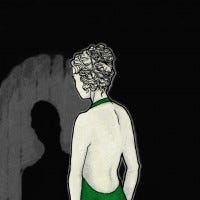Analysis: Featherlight Adventure - Narrative In Scarlett and the Spark of Life
Emily Short looks at storytelling and narrative in Scarlett and the Spark of Life, the first episode in a multi-stage iPhone graphical adventure from Launching Pad Games.

[Continuing her regular narrative analysis of newly launching video games, game writing veteran Emily Short looks at storytelling in Scarlett and the Spark of Life, an iPhone graphical adventure from Launching Pad Games.] "Scarlett and the Spark of Life" is the first episode of a multi-stage iPhone adventure offered by Launching Pad Games. It's kind of adorable. The still art is charming, and if the animation is on the simple side, that fits the style of the game. The heroine is plucky and sarcastic. The dialogue is funny, and several times reminded me of Telltale Games (a good thing, in my book). Often there are three or four conversation options that are all joke variations on the same idea, so it's fun to read the text but it doesn't make much difference which you pick. The puzzles are accessible and diverse, though they have the frankly contrived feel I associate with old-school graphical adventures: places where only one object will do even though others should be equally functional, where the key to a door can be found in a place it has no narrative reason to be, and where wild animals faithfully guard exits until bribed in just the right way. The most egregious example is one that involves attaching an object to a part of an animal's anatomy that I wouldn't really have considered as, er, an attachment point. All the same, none of them stumped me for long, and many of them are helpfully clued by the non-player characters. The interface is well designed for iPhone use, too. Some graphical adventures I've tried on the iPhone have been adapted from PCs. They wound up too fiddly and tiny, with pictures that were hard to view, hot spots that I couldn't hit accurately, etc. Scarlett and the Spark of Life scales everything down. Each screen has enough points of interest to make it feel interactive, but usually not more than four or five, well-spaced and with good hit reception. A button at the corner of the screen highlights those points. This first episode takes only an hour or two to play, but I think that's about right for a phone game: it's not the kind of thing you want to sit in front of for four hours at a time. Structurally, it's an absolutely standard adventure-game type of format: a linear intro, a mid-game with several distinct puzzles to collect items, and a linear conclusion, which provides the rising pace. Pacing and presentation are spot on, with tiny cut scenes that raise the tension as the player finishes more of the puzzles and approaches the climax of the story. The game ends with a victory of sorts -- it does feel satisfyingly like the end of something -- but there is still much more challenge ahead for the main character. So, overall, my impression of the gameplay is that Launching Pad has taken many of the classic concepts of graphical adventure games, and smoothed them down into an accessible format with an interface adjusted for mobile play. It's less of an innovation in content than a successful translation. The story also feels very much like a product of the game's functional requirements, though. I enjoyed Scarlett quite a bit, and admire its surface polish; but if I try to look deeper, there isn't much there. The premise is resoundingly silly. Scarlett and her sister Lavender are princesses, and they are kidnapped, separately, by villains with no apparent purpose other than villainy. The villain who caught Scarlett has a henchman who isn't that bad really (an important plot point). Through determination and cleverness, Scarlett manages to set herself free. Even though she's the princess, no one is really looking for her, and she's going to have to free Lavender as well -- but first she needs to assemble a robotic horse as her escape vehicle. This all takes place in a world where people wear plate armor but use steam boilers; where house paint comes in industrial cans and there are such things as accounting textbooks, but there is also some kind of near-alchemical magic that gives life to inanimate objects. It doesn't make sense, physically or socially, and it isn't supposed to. If anything, a sensibly-constructed and coherent world view would probably just make the goofiness of the puzzles stand out more strongly. Nonetheless, the world building is a touch less deft than one finds in, say, Telltale's recent Monkey Island episodes. Those are silly and full of anachronism but retain some essential defining traits: cartoonish piracy, voodoo, and lots of Caribbean and sea-themed color. The world of Scarlett doesn't offer any equally clear hooks, which I think may be a mistake, especially for a series game meant to bring players back again and again to revisit (and re-pay-for) its milieu. Thematically, there's a little more coherence, but only if you look for it. Many puzzles involve getting to know people (usually by asking them questions) and then helping them set their lives in order -- by which I mean that there are a lot of fetch quests, but also some NPC puzzles that just turn on having noticed the right things about the character and pushing them towards acting to their own advantage. The player reconciles a pair of sisters and convinces a character to follow his dream career. The story doesn't really do a great deal to expand on this theme, but it does provide an upbeat feel for most of the NPC challenges. All in all, Scarlett and the Spark of Life has lots of charm, not that much substance -- at least so far. It's an undemanding game that fits well with the divided attention people tend to give their phones. But I had fun, and I wouldn't say no to the next episode when it comes along. (Disclosure: I received a free review copy of this work.) [Emily Short is an interactive fiction author and part of the team behind Inform 7, a language for IF creation. She also maintains a blog on interactive fiction and related topics. She also contracts for story and design work with game developers from time to time, and will disclose conflicts with story subjects if any exist. She can be reached at emshort AT mindspring DOT com.]
About the Author(s)
You May Also Like







.jpeg?width=700&auto=webp&quality=80&disable=upscale)








